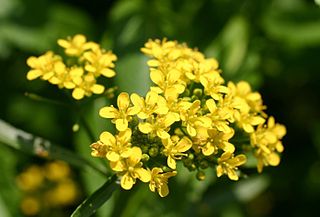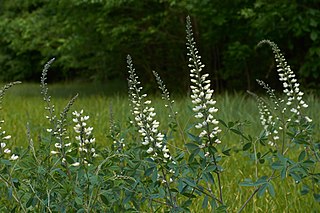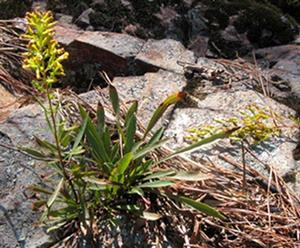
Rorippa is a genus of flowering plants in the family Brassicaceae, native to Europe through central Asia, Africa, and North America. Rorippa species are annual to perennial herbs, usually with yellow flowers and a peppery flavour. They are known commonly as yellowcresses.

Sesbania is a genus of flowering plants in the pea family, Fabaceae, and the only genus found in tribe Sesbanieae. Riverhemp is a common name for plants in this genus. Notable species include the rattlebox, spiny sesbania, and Sesbania sesban, which is used in cooking. Plants of this genus, some of which are aquatic, can be used in alley cropping to increase the soil's nitrogen content. The species of rhizobia responsible for nitrogen fixation in Sesbania rostrata is Azorhizobium caulinodans.

Baptisia australis, commonly known as blue wild indigo or blue false indigo, is a flowering plant in the family Fabaceae (legumes). It is a perennial herb native to much of central and eastern North America and is particularly common in the Midwest, but it has also been introduced well beyond its natural range. Naturally it can be found growing wild at the borders of woods, along streams or in open meadows. It often has difficulty seeding itself in its native areas due to parasitic weevils that enter the seed pods, making the number of viable seeds very low. The plant has low toxicity levels for humans.

Baptisia is a genus in the legume family, Fabaceae. They are flowering herbaceous perennial plants with pea-like flowers, followed by pods, which are sometimes inflated. They are native to woodland and grassland in eastern and southern North America. The species most commonly found in cultivation is B. australis.

Banksia sphaerocarpa, commonly known as the fox banksia or round-fruit banksia, is a species of shrub or tree in the plant genus Banksia. It is generally encountered as a 1–2 m (3.3–6.6 ft) high shrub, and is usually smaller in the north of its range. This species has narrow green leaves, and brownish, orange or yellow round flower spikes which may be seen from January to July. It is widely distributed across the southwest of Western Australia, growing exclusively in sandy soils. It is usually the dominant plant in scrubland or low woodland. It is pollinated by, and is a food source for, birds, mammals, and insects.

Banksia violacea, commonly known as violet banksia, is a species of shrub or tree in the plant genus Banksia. It generally grows as a small shrub to 1.5 m (5 ft) high with fine narrow leaves, and is best known for its unusually coloured dark purple-violet inflorescences. The colour of the inflorescences, short leaves, and flattened follicles which are sticky when young, help identify this species from others in the field. It is found in low shrubland in southern regions of Western Australia from Esperance in the east to Narrogin in the west, growing exclusively in sandy soils.

Baptisia tinctoria is a herbaceous perennial plant in the family Fabaceae. It is native to eastern North America.

Baptisia alba, commonly called white wild indigo or white false indigo, is a herbaceous perennial plant in the bean family Fabaceae. It is native in central and eastern North America. The plant is typically 2 to 3 feet tall, but can be taller, with white, pealike flowers.

Picramnia, the bitterbushes, is a genus of plant considered to be in the family Picramniaceae, but sometimes placed in Simaroubaceae. The name is conserved against the genera Pseudo-brasiliumAdans., and TaririAubl., both which have been rejected.

Banksia sphaerocarpa var. dolichostyla, commonly known as Ironcap Banksia, is a plant which is either considered a variety of Banksia sphaerocarpa, or as a species in its own right. It is native to the Southwest Botanical Province of Western Australia. Seeds do not require any treatment, and take around 33 days to germinate.

Baptisia arachnifera, commonly known as hairy rattleweed, cobwebby wild indigo, hairy wild indigo, and hairy false indigo, is an endangered species of flowering plant in the legume family. Its native habitat is limited to sandy soils in pinewoods along the coastal plain of the U.S. state of Georgia.

Erynnis baptisiae, the wild indigo duskywing, is a species of butterfly of the family Hesperiidae. It is found in North America from southern Ontario and New England, west to central Nebraska, and south to Georgia, the Gulf Coast, and south-central Texas.
Rorippa sphaerocarpa is a species of flowering plant in the family Brassicaceae known by the common name roundfruit yellowcress. It is native to North America, including the western United States and northern Mexico, where it grows in moist habitat, such as riverbanks and mudflats. It is an annual herb producing decumbent or erect stems up to 40 centimeters long. The leaves are up to 10 centimeters long and have blades are deeply divided into toothed lobes. The inflorescence is a raceme of mustardlike flowers with yellow petals each no more than a millimeter long. The fruit is a round silique 1 or 2 millimeters wide.

Catesbaea is a genus of flowering plants in the family Rubiaceae. It occurs in the West Indies, The Bahamas, and the Florida Keys. The genus is named in honour of English naturalist Mark Catesby.

Solidago plumosa is a rare species of goldenrod known by the common names Yadkin River goldenrod, plumed goldenrod, and plumose goldenrod. It is endemic to North Carolina in the United States, where it grows only on the banks of the Yadkin River. There is only one known population. It is a candidate for federal protection.

Dunnville Barrens is a Wisconsin Department of Natural Resources-designated State Natural Area featuring a jack pine barrens plant community on a wide, sandy Chippewa River terrace. Open areas in the barrens contain scattered shrubs, such as beaked hazelnut, with a groundlayer composed of dry sand prairie species, including little bluestem, purple prairie clover, and fameflower. The eastern portion of the site contains an open area of swale topography, with areas of both wet and dry prairie. Plant composition in this area is diverse and includes species such as big bluestem, cream baptisia, Michigan lily, downy gentian, prairie alum-root, and Culver's root. Uncommon animal species include gorgone checkerspot, Leonard's skipper, and five-lined skink.

Baptisia bracteata, otherwise known as longbract wild indigo, long-bract wild indigo, long-bracted wild indigo, plains wild indigo, cream false indigo, or cream wild indigo, is a perennial herbaceous plant in the Fabaceae (bean) family that is native to the central and eastern United States. It is one of the earliest blooming species of Baptisia, beginning to bloom in March in certain areas of the United States. The flower clusters (racemes) spread out sideways or sprawl across the ground, unlike most other Baptisia species, which have vertical racemes.

Baptisia nuttalliana is a species of flowering plant in the legume family known by the common name Nuttall's wild indigo. It is found in the south-central United States.

Trichapion rostrum, the baptisia seed pod weevil or wild indigo weevil, is a species of weevil in the family Brentidae.

Ludwigia sphaerocarpa, common names globe-fruited false-loosestrife, globefruit primrose-willow, round-fruited false-loosestrife, globe-fruited seedbox, globe-fruited ludwigia, spherical-fruited seedbox and round-fruited false loosestrife; is a plant found in North America. It is listed as endangered in Connecticut, Indiana, Massachusetts and Rhode Island, and as threatened in Michigan and New York (state). It is listed as extirpated in Pennsylvania.



















